Deer of the UK
10/10/2022
 The UK has a total of six unique deer species -- some native, some not so much, and many regarded as pests, particularly in the realm of conservation. Deer are notorious for being able to inhabit any habitat that offers food, shelter, security, and a relatively stress-free existence, and so they can be found anywhere from the depths of rural woodland to your backyard. Truthfully, our only truly native deer species are the Red and Roe deer, however other species such as the Fallow and Muntjac have become nativized. This page will cover all six, with some ID help, ecology facts, and notes about their behaviour -- plus any fun facts related to them! The UK has a total of six unique deer species -- some native, some not so much, and many regarded as pests, particularly in the realm of conservation. Deer are notorious for being able to inhabit any habitat that offers food, shelter, security, and a relatively stress-free existence, and so they can be found anywhere from the depths of rural woodland to your backyard. Truthfully, our only truly native deer species are the Red and Roe deer, however other species such as the Fallow and Muntjac have become nativized. This page will cover all six, with some ID help, ecology facts, and notes about their behaviour -- plus any fun facts related to them!
Problems with Deer
 Deer are popularly regarded as regal, elegant creatures, and to be clear I feel this way about them too! I think deers are absolutely beautiful creatures and I'm always excited when I see one, no matter what kind. However, truth be told, the UK is a very small area. After we successfully extirpated (made locally extinct) our natural predators such as bears and wolves, deer have nothing to keep them in check except us. A very large part of conservation and protection of priority habitats is surveying for deer presence, impact, and thereafter taking appropriate culling strategies. There is also a great market here to fund conservation efforts, which is often done! Deer are popularly regarded as regal, elegant creatures, and to be clear I feel this way about them too! I think deers are absolutely beautiful creatures and I'm always excited when I see one, no matter what kind. However, truth be told, the UK is a very small area. After we successfully extirpated (made locally extinct) our natural predators such as bears and wolves, deer have nothing to keep them in check except us. A very large part of conservation and protection of priority habitats is surveying for deer presence, impact, and thereafter taking appropriate culling strategies. There is also a great market here to fund conservation efforts, which is often done!
Below are some considerable impacts of a lack of deer management on a protected site, to contextualise the problems they cause in Britain.
Agricultural Damage
 Major problems with deer involving this form of damage include grazing, browsing, trampling, and livestock. Trampling or poaching is the act of ground erosion/damage caused by deer migration, and is particularly severe with herding deer. This can result in damage to agricultural lands as many grazing deer will feed at night in open fields, and crop fields are perfect for this. Grazing deer (red, sika, and fallow) will also favour cereal crops often grown on farmland such as oats, wheat, maise, triticale, and rye, as well as carrots, potatoes, and fruits (although less common). This damage to crops can result in poorer quality produce, and less of it at that, damaging profits. It has been estimated that deer cost the economy of eastern England around £3.2 million per year, particularly in the form of damage to agriculture (cereals in particular). Major problems with deer involving this form of damage include grazing, browsing, trampling, and livestock. Trampling or poaching is the act of ground erosion/damage caused by deer migration, and is particularly severe with herding deer. This can result in damage to agricultural lands as many grazing deer will feed at night in open fields, and crop fields are perfect for this. Grazing deer (red, sika, and fallow) will also favour cereal crops often grown on farmland such as oats, wheat, maise, triticale, and rye, as well as carrots, potatoes, and fruits (although less common). This damage to crops can result in poorer quality produce, and less of it at that, damaging profits. It has been estimated that deer cost the economy of eastern England around £3.2 million per year, particularly in the form of damage to agriculture (cereals in particular).
Deer can also cause damage to property related to agriculture. For example, deer can cause damage to fences, hedges, and trees used in forming boundaries for livestock or acres of farmland.
Forestry Damage
In the north east, a majority of our deer population consists of roe deer. These are solitary browsers – browsing meaning that they eat the new shoots of trees and low woody vegetation – meaning they can cause a lot of damage to forestry. Browsing prevents new growth, and forces the vegetation to grow unnaturally; stem densities will be reduced, as well as the height of growth and the density of the plant’s foliage. For the tree specifically, the additional energy required to regenerate from more severe or persistent browsing can be enough to kill it. On a broader scope the poorer foliage density means that the understorey of forests on-site will be more exposed, providing less cover for other species and removing habitats and food sources for fauna such as passerine birds (songbirds). It has been found that a high population of deer has extremely severe damage on low woody vegetation, particularly below 1.5m high, which means huge amounts of damage to shrubbery.
 On top of all of this, deer routinely cause fraying damage to forestry as they remove the velvet from their growing antlers. This bark scraping exposes the inside of trunks and leaves trees vulnerable to infection, as well as causing a lot of younger trees to snap and fall over. The height of this damage varies with the height of the species. On top of all of this, deer routinely cause fraying damage to forestry as they remove the velvet from their growing antlers. This bark scraping exposes the inside of trunks and leaves trees vulnerable to infection, as well as causing a lot of younger trees to snap and fall over. The height of this damage varies with the height of the species.
Environmental Damage
 This links in heavily to forestry damage. The aforementioned damage to growing trees can result in reduced canopy cover and a reduction in the density and cover of understorey vegetation, which leads to decreased habitat and food for songbirds. It has been found that deer-excluded areas of land had higher populations of songbirds, showing the extent of this damage. A reduction to the understorey also results in less cover and habitat for rodents and small mammals, such as hedgehogs, badgers, and ground-nesting birds, who are left exposed to predators. Moreover, the reduced biodiversity on the forest floor contributed to by browsing on flowering plants prevents diversity needed by our pollinators. A high deer density over a long period of time can result in a completely impoverished forest floor, ruining the woodland structure. This links in heavily to forestry damage. The aforementioned damage to growing trees can result in reduced canopy cover and a reduction in the density and cover of understorey vegetation, which leads to decreased habitat and food for songbirds. It has been found that deer-excluded areas of land had higher populations of songbirds, showing the extent of this damage. A reduction to the understorey also results in less cover and habitat for rodents and small mammals, such as hedgehogs, badgers, and ground-nesting birds, who are left exposed to predators. Moreover, the reduced biodiversity on the forest floor contributed to by browsing on flowering plants prevents diversity needed by our pollinators. A high deer density over a long period of time can result in a completely impoverished forest floor, ruining the woodland structure.
Rutting stands and trees that are returned to for fraying by individual deer often have frequently-used paths leading to them, which affect woodland plant growth by damaging surface roots. These paths also affect the soil structure and can force it to remain totally bare.
As well as all of this, a contributing factor to deer’s negative impact on the environment is actually their dung. Droppings in high-density deer populations will cause a higher amount of nutrient loading, altering the soil quality in a way that can favour certain species of plants, further reducing biodiversity.
Deer Overpopulation
 Due to being prey species, deer have evolved to have more young than necessary to sustain their population, and as the deer population covers the entire of Britain there are no areas for this high population to expand into, meaning overpopulation is a significant problem for them. Territorial species in particular, such as the roe deer commonly found in the north east, will suffer adverse effects from overpopulation simply due to more deer being forced to share less space, especially as they tend to stay in one area. Due to being prey species, deer have evolved to have more young than necessary to sustain their population, and as the deer population covers the entire of Britain there are no areas for this high population to expand into, meaning overpopulation is a significant problem for them. Territorial species in particular, such as the roe deer commonly found in the north east, will suffer adverse effects from overpopulation simply due to more deer being forced to share less space, especially as they tend to stay in one area.
As deer density increases in a woodland, the damage to its flora actually reduces its carrying capacity for the deer, as there is less security, food, and cover. This can force deer out of their habitats into farmlands, suburbia, heathlands, etc. and cause greater deer impact there. The amount of damage a high density deer population can cause – particularly when they are non-migratory – can take years to recover from.
|
Red Deer
Terminology: Stags, hinds, and calves
Lifespan: 18 years
Stature Just under 1.5m at shoulder for males, with females being around a metre tall. They are one of the largest species of deer, and Britain's largest land mammal.
Distribution: Found across the UK -- mostly in Scotland, southwest England, Northern Island. Prefer woodland but can be found on moors and hills.
Identifiers: Rusty red in summer, brown in winter. Adults are not spotted. Highly branched antlers that increase with age. 7-9cm long hooves (back are smaller). Females are also smaller than males.
Conservation Status: Least Concern, and a native species. Population in Scotland currently recovering due to increased woodland cover.
|
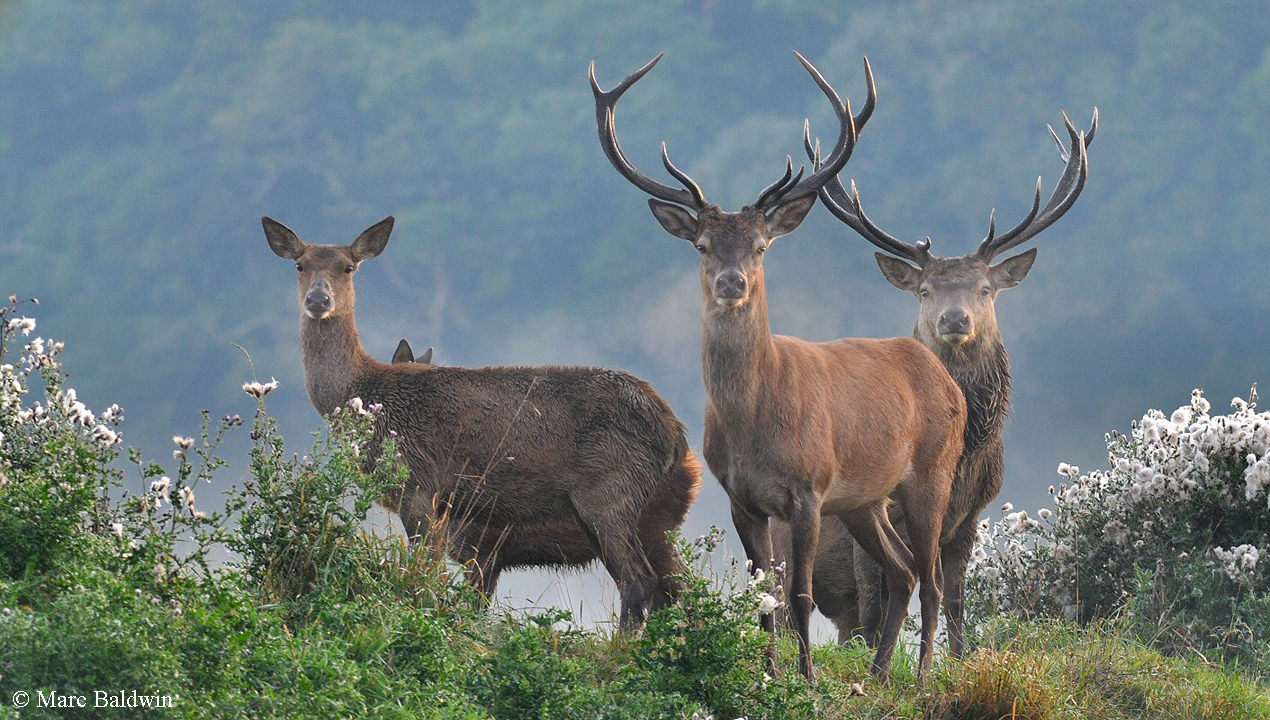
Fun Fact: They were historically known as "fairy cattle" in the Scottish Highlands, and it was believed that fairies would milk them on mountaintops.
|
Behaviour and Breeding 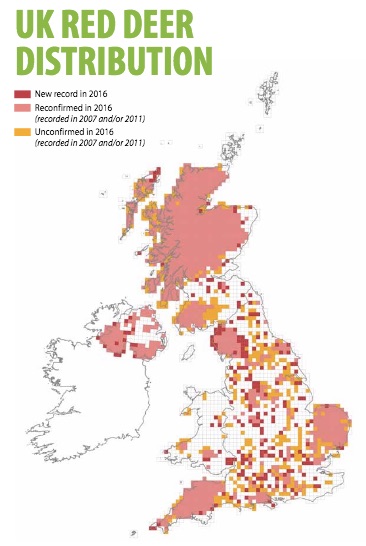
Red deer graze on grasses and dwarf shrubs (such as heather and bilberry) when available. During the winter, they tend to browse on woody elements, such as tree shoots. Although active at all hours, they are crepuscular at their peak times -- using open hills during the day and descending to lower ground at night.
They are very solitary creatures aside from during rutting, where they will gather in large groups in open fields. These can persist for most of the year. Otherwise, the most you'll see together are hinds with their young calves.
Red deer are sexually mature before the age of two, but stags tend to mate at five onwards. This is because stags have to compete in dominance displays, which include roaring, parallel walks, and fighting. These can potentially be lethal, so younger stags often don't involve themselves as they will naturally be less dominant than older, more mature stags.
History
The red deer migrated to Britain from Europe 11,000 years ago in around 9,000 BC, before the formation of the English Channel isolated them from the rest of Europe. In the neolithic ages, they a prime hunting target -- their meat was a great source of food, their skins used for clothing, and their bones and antlers used to craft tools.
During the growth of agriculture in the neolithic era (around 4,000 BC), large areas of woodland began to be lost for conversion into farmland, which reduced the habitat size of the red deer and made them more vulnerable. They became confined to the Scottish Highlands, south-western England, and other scarce, small populations throughout the Isles.
After the Norman invasion of 1066, they became protected in deer parks and what they called 'forests', which were generally without trees. This was done for the purpose of royal hunting. Then, throughout the Medieval period they lost this royal protection and their numbers decreased even further.
During the Victorian times (1837-1901), new "improved" red deer stock was re-introduced to the country. These new red deer were inter-bred with larger related species of mainland Europe and the Americas, such as the elk.
Current Status and Recovery
Fortunately, red deer numbers in the UK are now booming. Beginning in the Victorian era, escapees from deer parks would recolonise our woodlands, expanding as woodland coverage recovered since the early 1900s. They are now widely-distributed and ever-expanding in population across the Isles.
 Read more info from the British Deer Society... Read more info from the British Deer Society...

Roe Deer
Terminology: Bucks, does, and kids
Lifespan: 10 years
Stature:3/4 of a metre at shoulder.
Distribution: Widespread in woodlands everywhere except Northern Ireland. Mostly found on woodland/forest edges.
Identifiers: Males have three-branched, small "pearled/bearded" antlers. Prominent white rump with no visible tail, but females get a small hairy tuft during winter. Bright rusty red in summer and dull grey in winter. 4-5cm long with sharply pointed hoof prints.
Conservation Status: Least Concern, and a native species. Protected under 1991 Deer Act. Widespread across all of Europe.
|
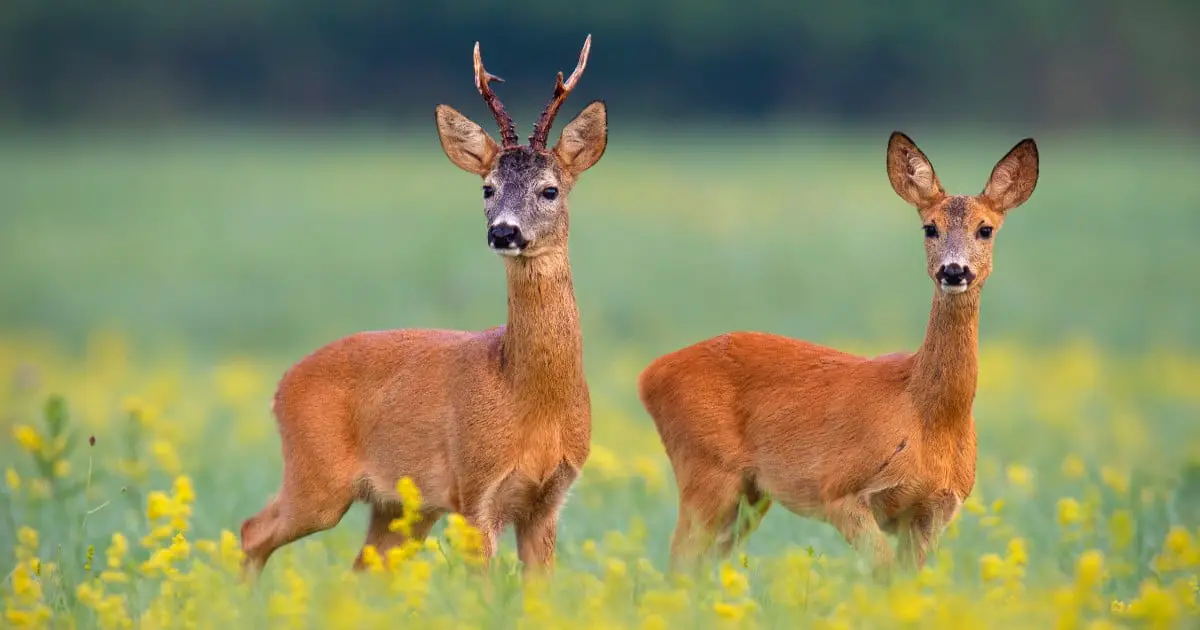
Fun Fact: In the original written work by Austrian-Jewish writer Felix Salten, Bambi was a roe deer! After the 1942 adaptation by Walt Disney, it became far more popular to portray him as an American mule deer.
|

Sika Deer
Terminology: Stags, hinds, and calves
Lifespan: 18 years
Stature: Just shy of a metre at shoulder.
Distribution: Patches across England and Northern Ireland, and actively spreading across Scotland. Prefer coniferous woodlands and acidic heaths.
Identifiers: Reddish fur with white spots. Heart-shaped white markings with black upper border on rump, with a white tail in the middle.
Conservation Status: Least Concern, with population rising. This is an invasive species from the East.
|

Fun Fact: "Sika" means deer in Japanese. These are originally native to China, Korea, and Japan. Ancient Chinese culture celebrated the sika as a symbol of power, wealth, and dignity.
|

Muntjac Deer
Terminology: Bucks, does, fawns
Lifespan: 18 years
Stature: Around half a metre at their shoulder. Very small!
Distribution: Very common in southern England, considered a pest by many!
Identifiers: Small and stout, with a hunched appearance (meaning their rumps are higher than their shoulders). Wide and flat tails with white undersides. Male bucks have small antlers with long furry pedicles (the base of the antler), and no branching. They also have a pronounced V-stripe on their faces. Does, on the other hand, have a dark crown patch on the forehead. They have small tusks.
Conservation Status: An invasive species from China. However, they are protected under the 1991 Deer Act. Sad and weird.
|
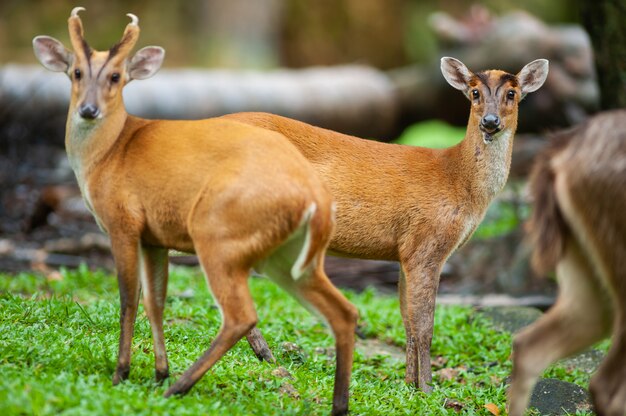
Fun Fact: Also known as "barking deer," they make repeated loud bark calls -- they also scream and squeak a lot when alarmed.
|

Fallow Deer
Terminology: Bucks, does, fawns
Lifespan: 16 years, although bucks generally live 8-10 years
Stature: Up to 90cm at shoulder, and up to 93kg in weight.
Distribution: Widespread in England and Wales with patches in Scotland, but most are found in southern England. Some have been seen in Northern Ireland. They are found in broadleaf woodland, open coniferous woodland, and open agricultural land.
Identifiers: There is a black inverted horseshoe shape on their rump, and they have the longest tail of all British deer. They are the only deer with palmate antlers that reach up to 70cm in length! They have elongated heads with large, angular ears. Several variations exist with pale white spots along their body.
Conservation Status: Considered nativised, and are locally abundant with a population on the increase. They are technically non-native.
|

Fun Fact: Fallow deer are considered non-native as they were introduced from mainland Europe by the Normans in the 11th century.
|

Chinese Water Deer
Terminology: Bucks, does, fawns
Lifespan: 6 years
Stature: They reach up to half a metre at shoulder like the muntjac, and weigh up to 18kg. Smalled!
Distribution: Restricted almost completely to the south/southeast of England in the wetlands. They inhabit reed beds, river shores, wet fenlands, and their neighbouring woodlands or fields. Bedfordshire, Cambridgeshire, and Norfolk see the most!
Identifiers: This species is known for their sharp tusks which protrude from their upper jaw. Both male and female CWD have these tusks, but males are slightly larger. They have short tails with no rump markings, and males have no antlers.
Conservation Status: Invasive, and restricted from stalking market due to their low spread. They were introduced to Britain in the 1870s, where they escaped from zoos (so original!). It is classified as an endangered species in its native country, and the population in Britain account for 10% of its global population!
|
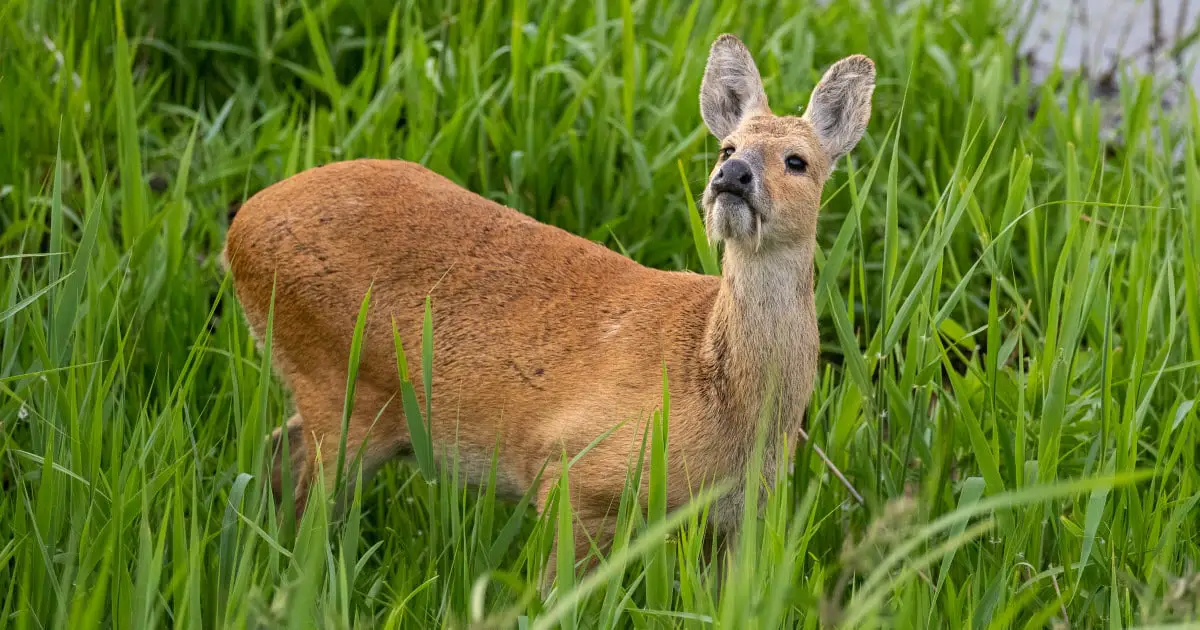
Fun Fact: They are originally native to the Yangtze flood plain in Eastern China, where they are called 河麂 (Hé jǐ) or 牙獐 (Yá zhāng), meaning 'toothed deer'. There is also a similar subspecies found in Korea. (Source) Although their fangs often grant them the name "vampire deer" they are also famous for their cuddly, teddybear-like appearance!
|

|






 The UK has a total of six unique deer species -- some native, some not so much, and many regarded as pests, particularly in the realm of conservation. Deer are notorious for being able to inhabit any habitat that offers food, shelter, security, and a relatively stress-free existence, and so they can be found anywhere from the depths of rural woodland to your backyard. Truthfully, our only truly native deer species are the Red and Roe deer, however other species such as the Fallow and Muntjac have become nativized. This page will cover all six, with some ID help, ecology facts, and notes about their behaviour -- plus any fun facts related to them!
The UK has a total of six unique deer species -- some native, some not so much, and many regarded as pests, particularly in the realm of conservation. Deer are notorious for being able to inhabit any habitat that offers food, shelter, security, and a relatively stress-free existence, and so they can be found anywhere from the depths of rural woodland to your backyard. Truthfully, our only truly native deer species are the Red and Roe deer, however other species such as the Fallow and Muntjac have become nativized. This page will cover all six, with some ID help, ecology facts, and notes about their behaviour -- plus any fun facts related to them! Deer are popularly regarded as regal, elegant creatures, and to be clear I feel this way about them too! I think deers are absolutely beautiful creatures and I'm always excited when I see one, no matter what kind. However, truth be told, the UK is a very small area. After we successfully extirpated (made locally extinct) our natural predators such as bears and wolves, deer have nothing to keep them in check except us. A very large part of conservation and protection of priority habitats is surveying for deer presence, impact, and thereafter taking appropriate culling strategies. There is also a great market here to fund conservation efforts, which is often done!
Deer are popularly regarded as regal, elegant creatures, and to be clear I feel this way about them too! I think deers are absolutely beautiful creatures and I'm always excited when I see one, no matter what kind. However, truth be told, the UK is a very small area. After we successfully extirpated (made locally extinct) our natural predators such as bears and wolves, deer have nothing to keep them in check except us. A very large part of conservation and protection of priority habitats is surveying for deer presence, impact, and thereafter taking appropriate culling strategies. There is also a great market here to fund conservation efforts, which is often done! Major problems with deer involving this form of damage include grazing, browsing, trampling, and livestock. Trampling or poaching is the act of ground erosion/damage caused by deer migration, and is particularly severe with herding deer. This can result in damage to agricultural lands as many grazing deer will feed at night in open fields, and crop fields are perfect for this. Grazing deer (red, sika, and fallow) will also favour cereal crops often grown on farmland such as oats, wheat, maise, triticale, and rye, as well as carrots, potatoes, and fruits (although less common). This damage to crops can result in poorer quality produce, and less of it at that, damaging profits. It has been estimated that deer cost the economy of eastern England around £3.2 million per year, particularly in the form of damage to agriculture (cereals in particular).
Major problems with deer involving this form of damage include grazing, browsing, trampling, and livestock. Trampling or poaching is the act of ground erosion/damage caused by deer migration, and is particularly severe with herding deer. This can result in damage to agricultural lands as many grazing deer will feed at night in open fields, and crop fields are perfect for this. Grazing deer (red, sika, and fallow) will also favour cereal crops often grown on farmland such as oats, wheat, maise, triticale, and rye, as well as carrots, potatoes, and fruits (although less common). This damage to crops can result in poorer quality produce, and less of it at that, damaging profits. It has been estimated that deer cost the economy of eastern England around £3.2 million per year, particularly in the form of damage to agriculture (cereals in particular).
 On top of all of this, deer routinely cause
On top of all of this, deer routinely cause  This links in heavily to forestry damage. The aforementioned damage to growing trees can result in reduced canopy cover and a reduction in the density and cover of understorey vegetation, which leads to decreased habitat and food for songbirds. It has been found that deer-excluded areas of land had higher populations of songbirds, showing the extent of this damage. A reduction to the understorey also results in less cover and habitat for rodents and small mammals, such as hedgehogs, badgers, and ground-nesting birds, who are left exposed to predators. Moreover, the reduced biodiversity on the forest floor contributed to by browsing on flowering plants prevents diversity needed by our pollinators. A high deer density over a long period of time can result in a completely impoverished forest floor, ruining the woodland structure.
This links in heavily to forestry damage. The aforementioned damage to growing trees can result in reduced canopy cover and a reduction in the density and cover of understorey vegetation, which leads to decreased habitat and food for songbirds. It has been found that deer-excluded areas of land had higher populations of songbirds, showing the extent of this damage. A reduction to the understorey also results in less cover and habitat for rodents and small mammals, such as hedgehogs, badgers, and ground-nesting birds, who are left exposed to predators. Moreover, the reduced biodiversity on the forest floor contributed to by browsing on flowering plants prevents diversity needed by our pollinators. A high deer density over a long period of time can result in a completely impoverished forest floor, ruining the woodland structure.
 Due to being prey species, deer have evolved to have more young than necessary to sustain their population, and as the deer population covers the entire of Britain there are no areas for this high population to expand into, meaning overpopulation is a significant problem for them. Territorial species in particular, such as the roe deer commonly found in the north east, will suffer adverse effects from overpopulation simply due to more deer being forced to share less space, especially as they tend to stay in one area.
Due to being prey species, deer have evolved to have more young than necessary to sustain their population, and as the deer population covers the entire of Britain there are no areas for this high population to expand into, meaning overpopulation is a significant problem for them. Territorial species in particular, such as the roe deer commonly found in the north east, will suffer adverse effects from overpopulation simply due to more deer being forced to share less space, especially as they tend to stay in one area.








